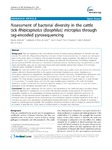Por favor, use este identificador para citar o enlazar este ítem:
http://www.alice.cnptia.embrapa.br/alice/handle/doc/897418| Título: | Assessment of bacterial diversity in the cattle tick Rhipicephalus (Boophilus) microplus through tag-encoded pyrosequencing. |
| Autor: | ANDREOTTI, R.  PÉREZ DE LEÓN, A. A.   DOWD, S. E.   GUERRERO, F. D.   BENDELE, K. G.   SCOLES, G. A.   |
| Afiliación: | RENATO ANDREOTTI E SILVA, CNPGC; Adalberto A Pérez de León, 2USDA-ARS Knipling-Bushland U.S. Livestock Insects Research Laboratory, 2700 Fredericksburg Rd., Kerrville, TX, 78028, USA; Scot E Dowd, 3Research and Testing Laboratory, Pathogenius, and Spirostat Technologies, 4321 Marsha Sharp Fwy., Lubbock, TX, 79407, USA; Felix D Guerrero, 2USDA-ARS Knipling-Bushland U.S. Livestock Insects Research Laboratory, 2700 Fredericksburg Rd., Kerrville, TX, 78028, USA.; Kylie G Bendele, 2USDA-ARS Knipling-Bushland U.S. Livestock Insects Research Laboratory, 2700 Fredericksburg Rd., Kerrville, TX, 78028, USA.; Glen A Scoles, 4USDA-ARS Animal Disease Research Unit, Washington State University, 3003 ADBF, Pullman, WA, 99164, USA. |
| Año: | 2011 |
| Referencia: | BMC Microbiology, v.11, p. 1-11, 2011. |
| Descripción: | Ticks are regarded as the most relevant vectors of disease-causing pathogens in domestic and wild animals. The cattle tick, Rhipicephalus (Boophilus) microplus, hinders livestock production in tropical and subtropical parts of the world where it is endemic. Tick microbiomes remain largely unexplored. The objective of this study was to explore the R. microplus microbiome by applying the bacterial 16S tag-encoded FLX-titanium amplicon pyrosequencing (bTEFAP) technique to characterize its bacterial diversity. Pyrosequencing was performed on adult males and females, eggs, and gut and ovary tissues from adult females derived from samples of R. microplus collected during outbreaks in southern Texas. Raw data from bTEFAP were screened and trimmed based upon quality scores and binned into individual sample collections. Bacteria identified to the species level include Staphylococcus aureus, Staphylococcus chromogenes, Streptococcus dysgalactiae, Staphylococcus sciuri, Serratia marcescens, Corynebacterium glutamicum, and Finegoldia magna. One hundred twenty-one bacterial genera were detected in all the life stages and tissues sampled. The total number of genera identified by tick sample comprised: 53 in adult males, 61 in adult females, 11 in gut tissue, 7 in ovarian tissue, and 54 in the eggs. Notable genera detected in the cattle tick include Wolbachia, Coxiella, and Borrelia. The molecular approach applied in this study allowed us to assess the relative abundance of the microbiota associated with R. microplus. This report represents the first survey of the bacteriome in the cattle tick using non-culture based molecular approaches. Comparisons of our results with previous bacterial surveys provide an indication of geographic variation in the assemblages of bacteria associated with R. microplus. Additional reports on the identification of new bacterial species maintained in nature by R. microplus that may be pathogenic to its vertebrate hosts are expected as our understanding of its microbiota expands. Increased awareness of the role R. microplus can play in the transmission of pathogenic bacteria will enhance our ability to mitigate its economic impact on animal agriculture globally. This recognition should be included as part of analyses to assess the risk for re-invasion of areas like the United States of America where R. microplus was eradicated. |
| Thesagro: | Boophilus Microplus Carrapato Sanidade Animal |
| Tipo de Material: | Artigo de periódico |
| Acceso: | openAccess |
| Aparece en las colecciones: | Artigo em periódico indexado (CNPGC)  |
Ficheros en este ítem:
| Fichero | Descripción | Tamaño | Formato | |
|---|---|---|---|---|
| bmcmicrobiology.pdf | 622,78 kB | Adobe PDF |  Visualizar/Abrir |









